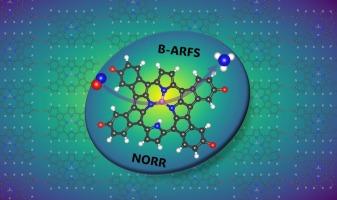硼化芳香环熔合结构:一种高效的电催化剂,用于从一氧化氮污染物中可持续合成氨
IF 7.5
1区 工程技术
Q2 ENERGY & FUELS
引用次数: 0
摘要
一氧化氮(NO)是氮氧化物(NOX)家族中的一种有毒活性物质,对人类健康和环境生态系统构成严重威胁,因此有必要制定有效的缓解战略。一个有希望的方法是将NO转化为有价值的化学产品,同时减少污染并促进可持续能源利用。为此,本研究探索了最近合成的硼化芳环熔合结构(B-ARFS)以NO为原料合成氨(NH3)的电催化潜力。计算分析表明,NO以N端对的方式与B-ARFS纳米结构紧密结合,优于其他吸附模式,如NO侧对和O端对。N端上的构型有利于电子的有效转移,有效地削弱了N=O键,为电催化NO还原反应(NORR)创造了最佳环境。气相中各种NORR机制的自由能分布表明,B-ARFS上的NORR在热力学上是一个有利的过程,其极限电位(UL)很低,为- 0.23 V。值得注意的是,引入溶剂介质使NORR成为一个自发过程。此外,与副产物H2 (HER)和N2形成相关的高能垒表明B-ARFS催化剂对NH3合成具有特殊的选择性。总的来说,这项研究强调了B-ARFS纳米结构在从NO污染物中产生环境可持续的NH3方面的变革潜力。本文章由计算机程序翻译,如有差异,请以英文原文为准。

Boronated aromatic ring-fused structure: An efficient electrocatalyst for sustainable ammonia synthesis from nitric oxide pollutant
Nitric oxide (NO), a toxic and reactive member of the nitrogen oxides (NOX) family, poses severe threats to human health and environmental ecosystems, necessitating the development of effective mitigation strategies. A promising approach involves converting NO into valuable chemical products, simultaneously reducing pollution and promoting sustainable energy utilization. To this end, this study explores the electrocatalytic potential of the recently synthesized boronated aromatic-ring fused structure (B-ARFS) for ammonia (NH3) synthesis using NO as a feedstock. Computational analyses reveal that NO binds strongly to the B-ARFS nanostructure in an N end-on configuration, outperforming other adsorption modes such as NO side-on and O end-on. The N end-on configuration facilitates the efficient transfer of electrons, effectively weakening the N=O bond and creating an optimal environment for the electrocatalytic NO reduction reactions (NORR). The free energy profiles for various NORR mechanisms in the gas phase demonstrate that the NORR on the B-ARFS is thermodynamically a favorable process with an appreciably low limiting potential (UL) of −0.23 V. Remarkably, introducing a solvent medium renders the NORR a spontaneous process. Furthermore, the high energy barriers associated with byproduct formation, including H2 (HER), and N2 show the exceptional selectivity of the B-ARFS catalyst for the NH3 synthesis. Overall, this study highlights the transformative potential of B-ARFS nanostructure in enabling environmentally sustainable NH3 production from NO pollutants.
求助全文
通过发布文献求助,成功后即可免费获取论文全文。
去求助
来源期刊

Fuel
工程技术-工程:化工
CiteScore
12.80
自引率
20.30%
发文量
3506
审稿时长
64 days
期刊介绍:
The exploration of energy sources remains a critical matter of study. For the past nine decades, fuel has consistently held the forefront in primary research efforts within the field of energy science. This area of investigation encompasses a wide range of subjects, with a particular emphasis on emerging concerns like environmental factors and pollution.
 求助内容:
求助内容: 应助结果提醒方式:
应助结果提醒方式:


